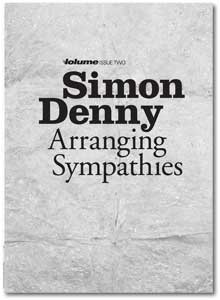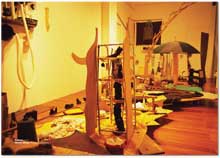 |
|||||||||
|
|
| ...Publications: Volume | ...Simon Denny: Arranging Sympathies | ||||||||||||||||
|
Simon Denny View Arranging Sympathies as a PDF [541 KB] Simon Denny Staccato Perhaps it was because of a recent close encounter with a John Bock work, one couldn’t say for sure, but there is something about the logic of Simon Denny’s sculptural practice which leads a viewer in the direction of vector mathematics. Vector mathematics is a curious area, largely confused by the non-clarity of its distinction. But a vague description could rest on the qualities of origin and trajectory; a vector has both a size and a direction, making it quite the magical brother in the fraternity of plotable points. Notes on the work: The difficulty in describing ‘vector’ is one of semantics. The term ‘vector’ is ambiguous, but its various meanings are interrelated. The different usages of ‘vector’ call for different formal definitions, which are similarly interrelated. For example, to a physicist, velocities, forces and fluxes are vectors, whilst to a geometer (or pilot), a vector is a kind of spatial displacement. In the language of programmers, ‘a vector is a sequence that supports random access to elements, constant time insertion and removal of elements at the end, and linear time insertion and removal of elements at the beginning or in the middle.’1 Notes on the work: Which of these related but exclusive vector definitions bears the closest resemblance to Simon Denny’s practice, and to Arranging Sympathies, is debatable—they all have their moments. The key is in the construction of the relationship between things. While independent objects—found, made or altered—create their own immediate conversation, the language is developed through the links and associations between these objects. Symbols of regeneration and fertility occur repeatedly; clumps of earth, sometimes dribbled randomly throughout the installation, or seeds and wheats, stuck to objects, bagged, or loose. Fragments are built. One element is connected to another—perhaps literally bound, maybe set to create visual discordance. The eye is lead from object to element via texture and finds itself back where it started, or repeated. A massive cone of thread; a bag of dried shitake mushrooms; seeds; kernels; an umbrella—painstakingly doodled; other things. A green wire basket attached to the wall, the kind that is lined with coconut fur in which you plant your plant; shelves everywhere, hooks everywhere. These are the starting points. The connections between them are the entities that create a spatial displacement, which have a size and a direction. Notes on the work (SD): Some of the points are more developed. They have form, they have reason. In a nod towards soft-core, more kitchen-based than industrial constructivism, structures begin to climb upwards with formal dignity. Spindly stick legs are bound into a free standing tower with rough, hairy twine. Snaking its way upwards, the twine finishes and is here adorned with more hooks, emerging from solid clumps of dried earth. The clumps hang like little dags, shivering. The tower is surrounded by a moat of dirty cotton wool. These points proliferate the scene, creating a community of instances from which the linear vector relationships are drawn. A little ramp skids down the edge of the twine tower, linking it with a cluster of hooks. Hovering above the green plastic wire bowl are licking flame shapes of a Memphis patterned surface. Emerging from this same bowl is a length of wooden trellis. It scissors across the room in an arc, creating a relationship between the wall, the bowl, the formerly negative space of the room, and leading the eye on down to the vitality beneath. ‘I like things that are hybrids rather than ‘pure’, convoluted rather than clearly articulated, as perverse as they are impersonal, as boring as they are interesting, conventional rather than ‘original’, all-embracing rather than exclusive, superfluous rather than simple, as old as they are innovative, contradictory and equivocal rather than clear and unambiguous. From what I have seen of unity, I prefer life to be haphazard.’ Robert Venturi2 Notes (SD): It is a practice which celebrates the microcosm of its system, and proffers no hierarchical justification. The smallest, most insignificant moment in an installation bears the same vital energy as a major, ambitious structure—one of the precise characteristics of vector programming. Playing around in a programme such as Macromedia’s Freehand, one knows the importance of a conclusive group philosophy of form. Any part of the sequence which is omitted makes the entire liner form unplottable. The points have a certain sense of community to them, independent but inter-reliant. Finite instances within Arranging Sympathies have a poetic independence. A single frame captures wide-spread brown corduroy trousers, laying flat on their back, and playing host to an oversized brown leather leaf with a quiffed tail perfectly fitted into the diminishing ‘v’. This is a point. The points are abrupt. They are crisp, they are without accentuation. They are equal and sharp. Staccato. Tessa Giblin Simon Denny graduated from Elam School of Fine Arts in 2004 with a BFA. Recent exhibitions include A Process of Bewilderment, Enjoy Gallery, Wellington; Tahi and Simon, George Fraser Gallery, Auckland; Simon Denny, Soo Ah Kim, Matt Ross, Creative NZ, Auckland; Ergophobia, Windowspace, Auckland; Water Relief Show, Room 103, Auckland; Snowball, Room 103, Auckland. Denny is the Chairperson of Special, an artist run initiative in Auckland. Tessa Giblin is a curator, most recently employed at ARTSPACE, Auckland. She is currently guarding the fundamental practice at The 51st Venice Biennale, and in 2005/06 will be participating in de Appel's Curatorial Training Programme, Amsterdam. Photo credit: Mark Gore. Design: Aaron Beehre 2 Robert Venturi, Complexity and Contradiction in Architecture, Museum of Modern Art, 1966
Related 20 July - 13 August 2005
|
||||||||||||||||

